It seems that in this day and age, people are becoming increasingly aware of the origins of their purchases, looking for environmentally friendly, low-carbon-footprint, ethical items and services. Many of us are trying to limit our impact on the world we live in, and those with whom we share it, human and animal. We all know the basics when it comes to being more sustainable and ethical in our everyday lives; cutting down on single-use plastic, staying away from fast fashion and eating less meat can all help save our planet, but what can we do when it comes to our jewellery box?
Fairtrade and sustainable products are becoming mainstream, and we are asking questions when we buy, more than just ‘does it suit me’ and ‘how much does it cost’.
A study by YouGov revealed that nine per cent of millennials believe that ethics are the single most important factor when it comes to buying or receiving an engagement ring. This might not sound like a huge number, but it’s a lot higher than it would have been if you asked the same question 25 years ago.
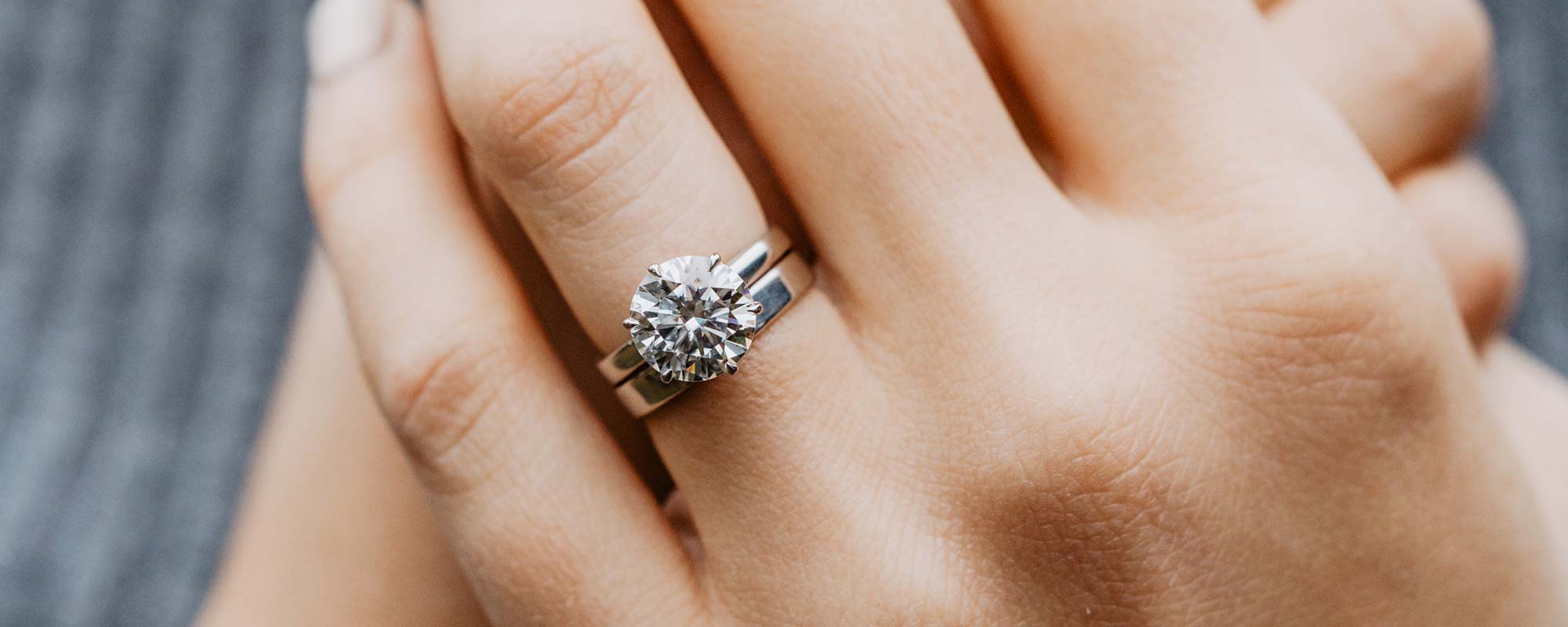
3.0ct Solitaire Engagement Ring Made using lab grown diamonds and recycled or Fairtrade precious metals, engagement rings from Ethica tick all the boxes for those of us who are looking to live more sustainably.
MINED DIAMONDS
Diamonds are formed deep in the Earth under conditions of extreme temperature and pressure, over thousands of years. They occur in concentration, in a type of rock called Kimberlite, and are not found in many places in the world. In order to extract them from the ground, mining must take place, or sometimes they can be found washed loose from their surrounding rocks, and can be sieved from the sandy soil. Where diamonds are found, there is stiff competition to possess them, and the people with the biggest budgets, or the nastiest bullies, usually win out, leaving those who carry out the back-breaking labour with barely a sniff of the riches available.
Find out more about this in our blogs:
Doubts About The Ethics of Diamonds
The True Cost of Mined Diamonds -Wildlife
The True Cost of Mined Diamonds - Water
True Cost of Mined Diamonds - Environment
The diamonds that are extracted are what is called ‘rough’ diamonds, unpolished, unremarkable-looking stones. These are traded in packages, dozens or hundreds of stones at a time, reaching those who cut and polish the diamonds, further down the line. They will be graded according to cut, colour, clarity and carat Diamond Buying Guide and sold to jewellers according to a very obscure and closely guarded pricing system, closely controlled by the industry, allowing prices to be manipulated according to market conditions.
Diamonds are undeniably beautiful, and the marketing from companies such as De Beers will try to convince you that they are desirable, and even essential when one is proposing to one’s girlfriend. There is also the ‘fact’ that one must spend an inordinate amount of money to achieve maximum sparkle. The mined diamond industry is less keen that you know about the murky side of their industry, the environmental damage, the human rights abuses and the questionable business practices, all of which we examine more closely in our blogs, if you’re interested.
True Cost of Mined Diamonds - People Part 1
True Cost of Mined Diamonds - People Part 2
THE TERM "ETHICAL DIAMOND" IS TOO WIDELY USED
Many jewellers will tell you that their diamonds are 'Kimberley-certified' and are therefore conflict-free and/or ethical, but this isn’t enough. The Kimberley Process Certification Scheme (KPCS) was introduced in 2003 in an attempt to eliminate the trade in conflict diamonds, however, diamonds produced in conflict zones are still being smuggled to KPCS regions to be certified.
The mining industry has taken a huge toll on the Earth, resulting in deforestation, soil erosion, relocation of local people, vanishing wildlife and desolate landscapes. When it comes to engagement rings and fine jewellery, diamonds are particularly problematic. Blood diamonds are mined in war-torn countries where conflict is often funded by the diamond trade where diamonds signify worker exploitation and atrocious human rights abuses rather than romance and commitment. Diamond miners are some of the poorest people on the planet and work in extremely dangerous conditions.
Historically, the diamond industry is well-known for conflict and its impact on the environment and still echoes the dangerous rippling effect of using blood diamonds. It can be an overwhelming worry whether your diamond was smuggled out of a war-torn area or caused hurt, which sadly still happens.
The problem is therefore far from eradicated, and blood diamonds from places like eastern DRC and Zimbabwe are still on the market. Jewellers may be able to trace a precious stone back to its source, but this doesn't guarantee that it is free from conflict as it passes through a host of procedures that may exploit young people including children and vulnerable people in the cutting and polishing processes for example where they are treated like slaves and not paid.
Unfortunately, by its very nature, diamond mining will never be a completely ‘green’ industry despite jewellers telling you that their diamonds are "ethical", creating huge open pits in the Earth in a previously untouched landscape will always have implications. There is absolutely no way of knowing that a mined diamond is conflict-free or therefore ethical and the jewellers that rely on the Kimberley Process Certification are just giving you lip service.

Mining for diamonds in Zimbabwe. Source: The Patriot
BUT A CANADIAN DIAMOND IS DEFINITELY "ETHICAL", RIGHT ?
You will also read that jewellers say that Canadian diamonds are an ethical choice. But they do not tell you about the damage to the delicate ecosystems, the environment and associated wildlife which may not be associated with humanitarian issues but the conflict to the environment, animals and indigenous people are devastating and the attempt to restore the damage that is being caused in the Ekati and Diavik mines in Canada has been reported to be woefully inadequate.
Diamond provenance
Questions have been asked for many years around the origins of diamonds, especially since the 2006 film Blood Diamonds starring Leonardo di Caprio brought the issues into the public eye highlighting a small but darkly disturbing side of the mining industry, the provenance of a diamond is becoming an increasingly important selling point. Buying an engagement ring should be a ‘feel-good’ purchase, and ethically savvy consumers are often reassured to find that a Canadian diamond ring comes with a laser inscription and ‘birth certificate’. The way diamonds are graded on the basis of the 4 Cs has always been skewed against traceability. The Canadians have been very successful in differentiating themselves on the basis of provenance.
Are all Canadian diamonds marked?
Not all Canadian diamonds are marked, but there are a number of programmes that offer a mine-to-market custody chain to provide assurance that the diamond has been ethically sourced in Canada and processed by approved manufacturers.
The Canadian Diamond Code of Conduct is a voluntary scheme set up in 2002 that assigns an identification number and code certificate to each polished diamond that is sold as ‘Canadian’. All the Canadian diamond mines are members, together with a large number of Canadian wholesalers, distributors and retailers. If a consumer buys a diamond from a retailer that abides by the code, the gem can be traced all the way back to the Canadian mine where it originated.
However, with rough diamonds that are shipped overseas, the process is slightly different. Each parcel is marked with a serial number to identify the mine of origin and, depending on their size, some stones are inscribed with a unique code. However, if the parcels are split up and mixed in with diamonds from other sources or larger gems are cut into smaller stones, the tracking of individual diamonds becomes extremely difficult.
So just because a diamond was mined in Canada, it does not mean it was cut and polished locally. The diamond-cutting industry in Canada is still relatively small so most rough Canadian diamonds are shipped overseas to be sold and cut in countries such as Israel, India, Belgium and Vietnam.
You can read more here:
Are Canadian Diamonds Ethical? - Part 1
Are Canadian Diamonds Ethical? - Part 2
Are Canadian Diamonds Ethical? - Part 3

Jericho Mine in Canada Jericho Mine in Canada. Source: nunalogistics.com
MAN-MADE/ LAB-GROWN DIAMONDS
Many consumers have chosen to move away from diamonds altogether, distrusting everything to do with diamonds of any kind, however, there is an alternative that has been growing in popularity and availability in recent years. Laboratory-grown diamonds, also known as man-made diamonds, are visually and chemically identical to mined diamonds – specialist equipment is the only way of telling them apart. They are composed of carbon, and have the exact same properties of light dispersal (the sparkle) and durability (the ’forever’ part of De Beers’ marketing). However, as the name suggests, they are not mined, but created in a lab. Apart from being called laboratory diamonds, they are also referred as synthetic diamonds, grown diamonds and man made diamonds.
There are two ways of creating lab grown diamonds, the first of which was developed in the 1950s to make industrial diamonds for cutting. This is HPHT, High Pressure, High Temperature, recreating the conditions under which diamonds are formed in the Earth, and requiring enormous amounts of energy.
The more modern method is CVD, Chemical Vapour Deposition, where a seed crystal, usually a diamond fragment, is placed in a methane-rich chamber and subjected to microwaves or plasma rays. This causes the methane to break down into carbon, which condenses on the seed crystal, and water, which is the only by-product of the process. Creating a 1 carat stone can take several weeks, by either method, although methodology is improving all the time, and manufacturing speeds are coming down, which is good news, as the CVD process is also quite energy-intensive and some question how can they be that more ethical because of the energy required to create them?
Lab-grown diamonds are generally priced according to the mined-diamond pricing strategy, which is not as ethical as one would hope; but they are sold at a greatly reduced cost based on the natural diamond pricing method. They are usually marked, laser etched or similar, in order to distinguish them from their mined counterparts.
In both cases, the diamonds are then cut and polished as a mined diamond would be, but without the ethical and environmental questions being raised.
But are they really that ethical?
SO, WHAT DOES "ETHICAL" REALLY MEAN?
How can you buy a truly ethical engagement ring, and how can you avoid purchasing gems with a dubious record around environmental and humanitarian issues? Many people ask how a lab diamond is more ethical considering the amount of energy that is required to grow them above ground. Over the past few years, more and more power house factories have been built to facilitate the manufacturing of these gems, with little or no regard for the contribution to climate change that their existence are causing. This is because the majority of them are using the dirtiest energy, fossil fuel, to power them. This obviously leaves a big question mark about how are they any better for the environment than mined diamonds as both are contributing a great deal towards the devastating effects of climate change.
The good news is that it is possible to purchase genuinely ethical diamond jewellery that won't have devastating links or questionable sourcing. What's better yet, you don't have to sacrifice on quality or style in doing so.
We do things differently to most other jewellery companies who dabble in both sides of the coin when it comes to diamonds. Many of which are simply following the “ethical trend”, which is commonly known as green washing the consumer, a process of conveying a false impression or providing misleading information about how a company’s products are more environmentally sound.
We work only with suppliers that grow their diamonds with the highest environmental respect and line up with our strict ethical standards. We carefully select a handful of growers who are utilising fully renewable energy, or using partially renewable energy and offsetting by purchasing more carbon from the atmosphere, than it takes to grow each carat of diamond. Currently there are only a handful of growers in the world that utilise renewable energy to grow their diamonds, and these are the only suppliers that we use for our lab grown diamonds.
The Ethica Diamond® (our signature stone) is also completely lab grown, meaning no devastation caused to the environment from mining and we also use sustainably sourced coloured gemstones that comply with these same ethical standards. And that's not all, we use fully recycled/recyclable packaging with 100% natural product (tissue paper, inks, paper, boxes, mailer bags etc) and the server that we use to host our website uses 100% renewable energy, too. Furthermore, the precious metals that we use are either Fairtrade or predominantly SCS certified recycled.
You can read more here:
ENSURING YOUR ENGAGEMENT RING IS ETHICAL
If you are a person who chooses with their heart, looking at the ultimate cost of your purchases for the Earth and those of us who live on it, then a mined diamond is probably not a direction you want to take. Likewise newly-mined gold or platinum. A diamond engagement ring is a symbol of your future together as a couple, so if you’re ethically minded, an ethical engagement ring is essential. The Ethica Diamond or a lab grown diamond, set in recycled or Fairtrade gold or platinum, is a good start to tick the right boxes, and Ethica has a variety of beautiful designs, so you’re sure to find something that ticks other boxes for you.

Aesa set in 950 Platinum Aesa set in 950 Platinum.
METALS
When choosing an engagement or wedding ring, the smart purchaser looks not only at the origins of the diamond, but also at the metal of the ring itself. Gold mining is one of the most environmentally un-friendly processes undertaken by man, using mercury to extract gold from its ore, causing untold damage to ecosystems and workers alike. This is only the very short version - you can read more about it here - Metal Type Guide.
There are two alternatives, for gold – to use recycled gold, that has been used before, and extracted from jewellery, computer parts or other sources, and re-shaped into your ethical engagement ring. The other option is to use Fairtrade gold. This is mined under carefully regulated conditions which ensure proper health and safety protections and proper pay for the miners, and environmental regulation as well. Fairtrade gold carries a slight premium, to allow for the increased regulation and pay.
Platinum, which is our most popular option for diamond engagement rings and wedding rings, does not have an organised Fairtrade designation, yet. Hence our platinum is sourced from mostly all recycled, from catalytic converters, and other primary sources, and repurposed into your ethical wedding ring or engagement ring.
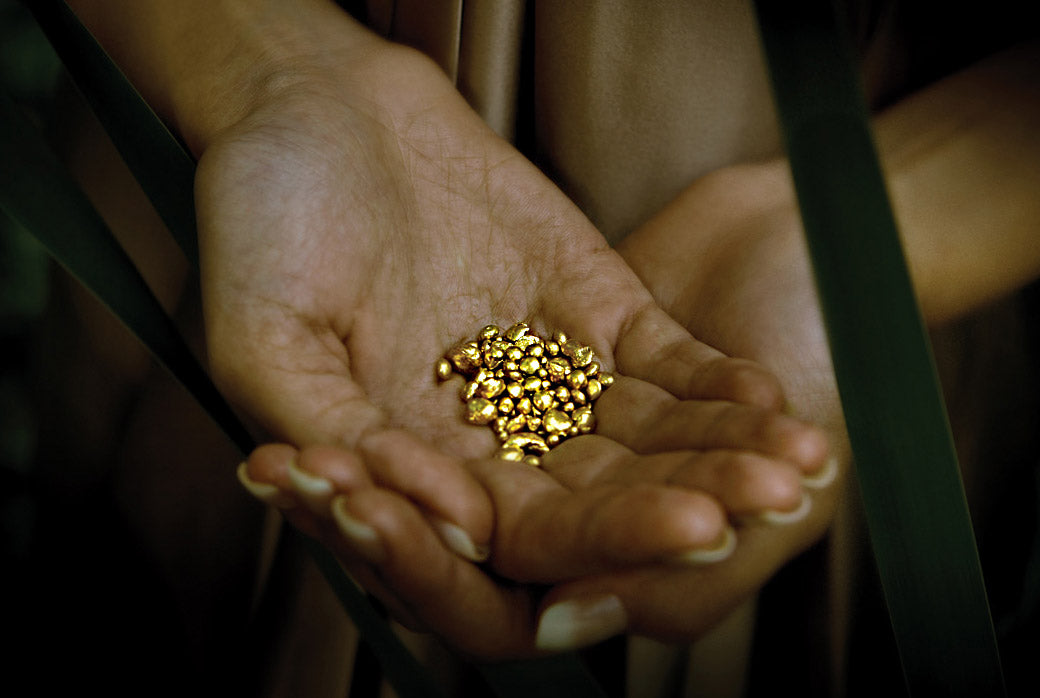
Hands with gold. We use Fairtrade gold to cast our jewellery, or recycle pre-existing surface gold. The quality is the same for both, since gold can be melted down and reused.
WHERE WAS THE RING MANUFACTURED?
Most jewellers manufacture their pieces in Asia as it's cheaper for business, but comes at the expense of poor working conditions and pay. Your jeweller should be able to tell you exactly where your jewellery was made, and ideally the names of the craftsmen and women who created it.
Ethica use craftsmen and designers from the UK, so you know that your ring hasn’t been manufactured under unfair conditions. This also ensures that your piece of jewellery has not had to travel hundreds of miles around the globe.
In a similar way to the food industry, a high-quality restaurant will be able to tell you exactly where they got the food on your plate from, a jeweller should be able to trace back where the metal and stone is from and how and where the ring was manufactured. If there is any hesitation, it's probably best to take your money elsewhere.
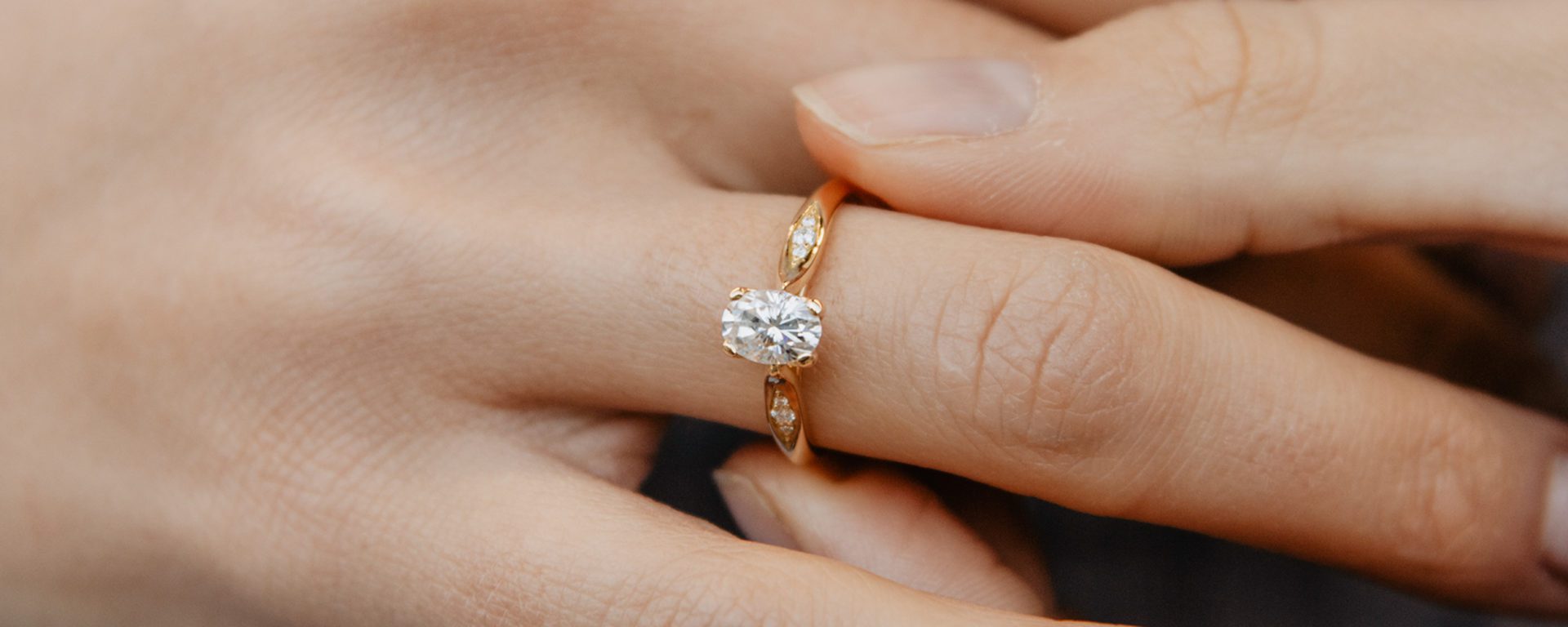
Celia set in Fairtrade 18k Gold.
Read Next

Colour is the New Classic: Engagement Ring Trends to Watch
This summer, coloured engagement rings are taking over. Discover why modern couples are choosing lab-grown stones for their ethical beauty, individuality, and timeless charm.
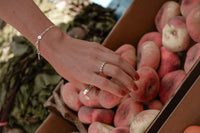
Your Love Story, Uniquely Told: Three Ways We Make Engagement Rings Truly Yours
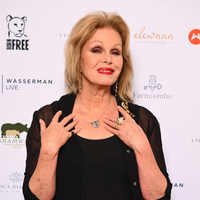
Ethica Collaboration With Joanna Lumley For Born Free Foundation
Ethica has created a unique pendant and the proceeds will support Born Free's conservation efforts, reflecting our commitment to giving back and making a positive impact.


